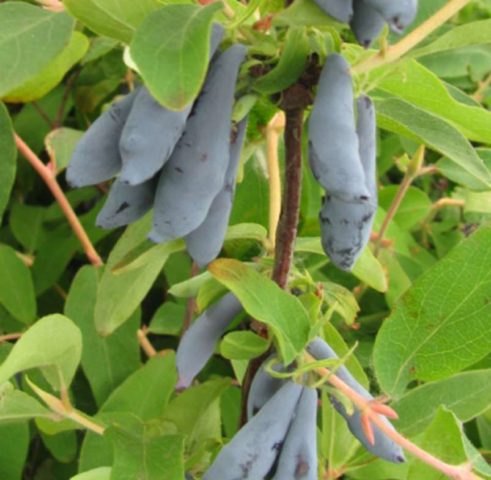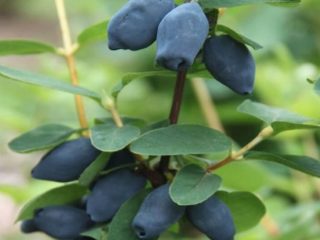Content
The variety of Gzhelka culture was created by a non-professional breeder L.P. Kuminov and entered into the State Register in 1988. For 30 years, the amateur has been breeding new varieties with high gastronomic qualities, using Kamchatka and Magadan species. The description given by the originator and reviews of honeysuckle variety Gzhelka completely coincide; in terms of taste, the culture received the highest rating on a 5-point tasting scale.

The berries are arranged in pairs, sometimes fused at the side
Description of honeysuckle Gzhelka
Gzhelka is a mid-season variety, blooms in the second half of May, bears fruit in July. The yield is high - 2.5-3 kg per bush. Honeysuckle is a frost-resistant plant, suitable for growing in all regions with a temperate climate; it feels less comfortable in the south.
The external characteristics of Gzhelka honeysuckle are as follows:
- The shrub grows up to 2 m, medium-spreading, shoot formation is intense - up to 40 pcs. per season.
- The shoots are erect, with bare, smooth brown bark; the skeletal branches are rough, brown with a gray tint and peeling areas.
- The foliage of the Gzhelka variety is dense, the leaf blades are bright green, pointed upward, with fine pile.
- The flowers are pink, arranged in pairs or singly in the leaf axils of honeysuckle.
- The berries are dark blue with a silvery coating, crescent-shaped, with a lumpy surface. Length – 2-2.5 cm, weight – 1-1.2 g.
- The peel is dense, the flesh is light beige, juicy, sweet, and there is no bitterness in the taste.
- The berries do not fall off, they are dry and can be baked at high temperatures in an open area.
Honeysuckle Gzhelka is a decorative plant used in landscape design.
Planting and caring for Gzhelka honeysuckle
Frost-resistant honeysuckle Gzhelka, based on northern species, is undemanding in care. It has high viability and survival rate in a new place, but still needs an approach that meets its biological requirements. When placing the Gzhelka variety on a plot, the degree of drought resistance of honeysuckle and the need for lighting are taken into account. For full growth, fertilizers are applied and seasonal pruning is carried out.
Landing dates
Honeysuckle with early sap flow. If the buds begin to grow, the plant will endure planting measures painfully. The survival rate will be worse, so spring planting of the Gzhelka variety in a temperate climate is not considered. After harvesting, the biological processes of honeysuckle slow down, and by autumn the plant enters a dormant phase. This feature is characteristic of both the adult Gzhelka variety and seedlings. Therefore, planting activities are carried out 1.5 months before the onset of frost.
Selection and preparation of a landing site
The preferred soil composition for the Gzhelka variety is slightly acidic or neutral. An inappropriate alkaline indicator must be corrected; if this is not done, honeysuckle will begin to lag in growth. Sandy or clayey heavy soils are not suitable for the variety; the best option is fertile, drained loams with good aeration.
For complete photosynthesis of Gzhelka honeysuckle, a sufficient amount of ultraviolet radiation is necessary, but at the same time, in an area open throughout the daylight hours, the berries can be baked. The place is protected from the north wind so that the honeysuckle is not exposed to the midday sun, but is partially shaded. The south side behind the wall of the building is good.
Do not choose a place in the lowlands, ravine, where moisture accumulates. Often, excess water causes root rot and the spread of fungal infection. In the worst case, the seedling may die. After selecting a site, dig it up, get rid of weeds, and adjust the soil composition if necessary. The landing hole can be prepared in advance or on the day of the work.

The crop blooms abundantly, the main formation of buds is on the tops of annual shoots
Landing rules
Planting material purchased from a nursery with a protected root system does not require additional measures before being placed in the ground. The protective material is removed from the seedling or removed from the pot and immediately placed in a hole. If the root is open, disinfect it with a manganese solution, immersing it in the product for two hours. Then they are kept in a growth stimulator for a certain time according to the instructions.
Landing sequence:
- Dig a hole so that it is wider than the root system.
The top layer of soil is folded separately to the side
- The bottom is covered with a layer of drainage.
- Prepare a fertile substrate from compost and peat, add superphosphate to it.
- Part of the mixture is poured onto a drainage pad.
- Place the honeysuckle in the center and pour out the rest of the substrate and compact it.
Compact each poured layer of soil so that there is no void near the root
- The hole is filled with earth so that the root collar remains 4 cm above the surface.
- Cut the honeysuckle stems to five buds, water and cover with mulch.
When mass planting, the interval between plants is 1.8 m.
Watering and fertilizing
The drought resistance of the Gzhelka variety is average; young plants may die if the root ball dries out. In the first growing season, the seedling is watered with a small amount of water so that the soil is not dry and waterlogged. During drought, approximately at intervals of 2-3 days. The watering regime for adult honeysuckle is determined by the frequency of precipitation. The main condition is to prevent the soil from drying out.
The honeysuckle seedling does not require feeding until it is two years old; it receives enough nutrition from the mixture added during planting. Activities begin from the moment of budding, introducing urea and organic matter. At the end of the season, fertilize with a complex mineral composition and compost; fertilizing promotes the development of vegetative buds in the spring.
Pruning honeysuckle variety Gzhelka
When pruning, the biological feature of honeysuckle is taken into account - the plant’s main fruiting is on the tops of annual shoots. If the branches are two years old, they will produce berries, but in much smaller quantities, and will take in the nutrients in full.
Basic rules for pruning:
- get rid of perennial branches, leaving only skeletal ones;
- annuals are partially cut out after fruiting; the main harvest of the next season will come from the shoots of the current year;
- remove weak, deformed stems growing in the central part of the bush.
Wintering
The frost-resistant plant, native to the northern regions, can easily tolerate temperatures dropping to -350. After four years of growing season, honeysuckle does not require crown cover for the winter. The shrub is given water-replenishing watering, fed with organic matter, and the soil near the root is mulched.
Young plants, especially in the first two years of life, have not had time to form a full-fledged root system and accumulate enough nutrients to easily withstand frost. Honeysuckle Gzhelka after planting requires additional measures before winter:
- The shrub is watered abundantly and hilled.
- Cover with mulch.
- The branches are pulled together and secured with rope.
- The top of the crown is wrapped with burlap or any covering material.
- In severe frosts, you can additionally insulate it with spruce branches.

Burlap or spunbond can be used as a covering material
Reproduction of edible honeysuckle Gzhelka
The variety is a selection, so it will not be possible to propagate Gzhelka honeysuckle generatively. Planting material will produce young shoots, but the plant will not retain its varietal characteristics. The berries are small with a tart, bitter-sour taste. Therefore, the Gzhelka cultivar is propagated only vegetatively.
Dividing the mother plant - for this purpose, use an overgrown bush after five years of age. The transplantation event is carried out at the end of fruiting.
They use the method of propagation by layering. In the spring, the lower branch is fixed to the surface and covered with soil. In the fall you will see which vegetative buds have taken root. The cuttings are covered for the winter and planted out in the fall the next season. It takes two years from laying a cutting to obtaining a full-fledged bush.
The most effective and fastest way to propagate Gzhelka honeysuckle is cuttings. Cuttings are taken at the end of fruiting from annual shoots. Place in the ground at the beginning of the next season. When the temperature has stabilized at a positive level, seedlings are selected for the site.
Pollinators of honeysuckle Gzhelka
The Gzhelka cultivar produces female and male flowers, is self-sterile, and requires pollination. This is done with honeysuckle mainly by bees, less often by butterflies and bumblebees. Early varieties bloom first on the site; there are no problems with pollination. The Gzhelka variety does this later. When honey plants bloom, bees rarely visit the bush. To attract insects, honeysuckle is sprayed with syrup.
Honeysuckle Gerda and Kucha Mala are planted next to the Gzhelka variety.

Gerda blooms at the end of May

Heap is small - a mid-season variety of crop
Diseases and pests
From a wild variety, the Gzhelka cultivar received high immunity to most fungal and viral infections. If the location is properly allocated and agricultural practices are followed, the plant will not get sick. During the rainy season or with excessive watering, powdery mildew infection may occur.The Gzhelka variety shrub is treated with preparations, for example, “Topaz”.

Fungicide inhibits the growth of fungal spores
If an infection is detected, the affected parts of the crown are cut off and removed from the site.
Among the pests that parasitize honeysuckle are:
- aphid;
- leaf roller;
- scale insect.
For preventive purposes, the Gzhelka variety is treated with Bordeaux mixture at the beginning and end of the season. They get rid of pests with “Aktara” and “Fitoverm”.

Contact insecticide

Biological product non-toxic for animals
Conclusion
Descriptions and reviews of honeysuckle variety Gzhelka will help you get a general idea of the variety and make a choice in its favor. The shrub is used in two ways: to produce berries with high taste and a numerous set of substances beneficial to the body, and also as an element of decorative gardening. Variety Gzhelka with simple agricultural technology and good frost resistance, undemanding to the composition of the soil.
https://www.youtube.com/watch?v=AuE-t7YytS4










